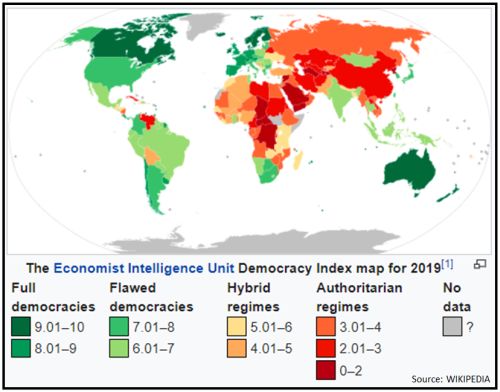Dec 26, 2025
Dec 26, 2025
The concept of Democracy dates back to more than two millennium. It is prevailing in different forms in different countries all over the world. A well-known phrase is that democracy signifies “Government of the people, by the people and for the people”. Democratic governments are expected to function so that people of have freedom of assembly and speech, freedom of religion, inclusiveness and equality, membership, consent, right to live and so on. All the prevailing democracies in the world today have the foregoing tenets as the cornerstones.
The question is whether people of two different countries enjoy the privileges to the same extent. The answer is a big NO. All democracies are not equal. The next question is whether it is possible to quantify and compare different democracies. The answer is YES as a UK based private company known as Economist Intelligence Unit (EIU) has been engaging in this activity for the last fifteen years. Every year, EIU comes out with a new report. The heart of these reports are the so-called “Democracy Indices” they assign to different countries based on performances during the preceding year. The Democracy Index of any country is a number between zero and ten. A higher number signifies a healthier democracy. The present article is based on the information available in these reports. More information related to EIU’s reports can be had from the relevant page in Wikipedia.
Democracy indices are calculated on the basis of answers to questions set by EIU. The answers are provided by the citizens of the countries concerned. The questions are grouped in five different headers. They are ELECTION PROCESS AND PLURALITY, FUNCTIONING OF THE GOVERNMENT, POLITICAL PARTICIPATION, POLITICAL CULTURE and CIVIL LIBERTTIES. Countries’ performances are evaluated separately in each of the groups (again in a scale of zero to ten). The average of these numbers is taken to be the applicable Democracy Index. One can argue that there can be arbitrariness and subjectivity associated with the process. However, what matters here are the relative numbers. As long as apples are compared apples and oranges with oranges there need be no scope for doubt and scepticism.
Depending on the overall democracy index (DI), the country concerned will be placed in one of the four groups. Description of the four groups is given below.
1. 1. Full democracies (DI > 8) are nations where civil liberties and fundamental political freedoms are not only respected but also reinforced by a political culture conducive to the thriving of democratic principles. These nations have a valid system of governmental checks and balances, an independent judiciary whose decisions are enforced, governments that function adequately, and diverse and independent media. These nations have only limited problems in democratic functioning. Typical countries: Canada, Australia, UK, Sweden.
The map below gives an idea of Democracy Indices all over the world as of the last year (2019). The western hemisphere is almost fully green indicating dominant presence of democracy in the associated regions. Africa, Europe and Asia regions are dominated by orange, red and maroon indicating that the regimes are predominantly of hybrid or authoritarian types.

The Table below gives representative DI-related data as of 2019. Norway tops the list with near perfect score. America is marginally in Group 2. India is not faring well as it occupies 51st slot among 166 countries included in the study. We will take a closer look into India’s status in a follow-up article.
.jpg)

The data available in the map has been summarized in terms of numbers as presented in the Table above. About 48 per cent of the world population are enjoying democratic regimes of varying degrees. It is notable that out of this 48 per cent only about 5 per cent are governed by “full democracy” regimes. Thus for all practical purposes, “flawed democracies” can be considered to be democracies in their own rights. About 53 per cent are less fortunate as they endure either pseudo or sham democratic governance or are ruled by authoritarian governments.